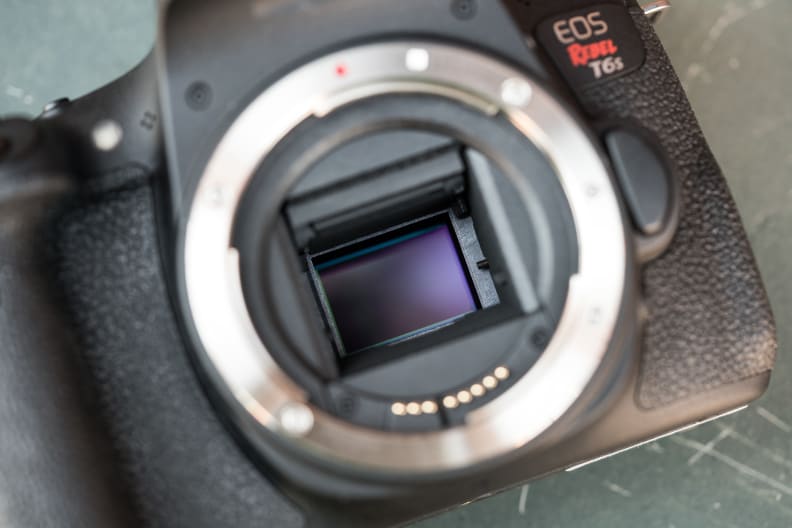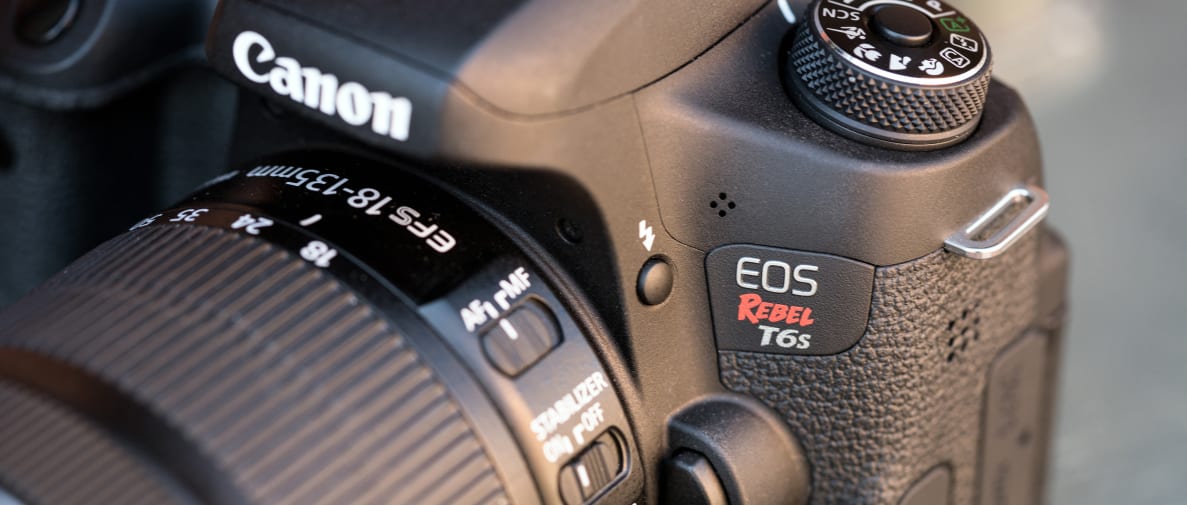Pros
-
Additional control dial
-
Beginner friendly
Cons
-
Lacks sharpness in video
But since Canon released the Rebel T2i in 2010, very little has changed with the line. Other than small refinements here and there, the last few years of Rebel DSLRs have heavily relied on the brand's good name and ease-of-use while skipping meaningful hardware upgrades. That finally changed this year with the Canon Rebel T6i, which brought with it a higher resolution sensor, improved low light and continuous shooting, and built-in WiFi.
The T6i was nice, but it's still basically the same old Rebel with a new sensor. The new Canon Rebel T6s (MSRP $1049 w/ 18-135mm, $849 body-only) is something more, taking all the features of the T6i, as well as a few new video features, a secondary LCD display, and a quick control dial. But with a kit price already north of $1,000, is it really worth getting this over the more affordable Rebel cameras on the market?
Design & Handling
Design changes on a Rebel?!
Entry-level cameras are built to be approachable. It's a technique that Canon has mastered, with its cameras being simple enough that you're not afraid to pick it up while serious-looking to the point that you feel like you got your money's worth. Balancing high-end features and ease-of-use, the Rebel line has become one of the most recommended lines for beginners.
But while the Rebel formula has been a successful one for years, it gets a few overdue changes with the new T6s, including a layout that'll help people who already know their way around a camera. This is particularly true with the secondary LCD on top, which provides a quick breakdown of crucial information such as ISO, exposure compensation, battery life, WiFi status, shutter speed, and aperture.

The biggest design addition to the T6s has to be the secondary information panel.
The camera also finally gets a dual-purpose control wheel that can function like a d-pad. This gives you an extra dial so users can quickly control exposure compensation or aperture while shooing in manual mode. Changing these settings on other Rebel models requires you to hold an additional button while using the top control wheel. In short, this makes changing major settings much easier, so you have a smoother flow while shooting.
These two changes might not sound like much, but after five years of minimal changes, they're significant. It also gives users a taste of what to expect should they move into Canon's enthusiast and professional level cameras, like the EOS 70D or EOS 7D Mark II. Since it's positioned as a slight step up from other Rebels, the T6s is a great choice for a user that may want to upgrade from an older Rebel, but isn't quite ready for Canon's higher end cameras. In short, this is what the Rebels with "i" in the model name should've been all along.
{{ photo_gallery name="Tour" }}
Outside of these two changes, the T6s is nearly identical to previous Rebel cameras. The controls are intuitive, clearly marked, and make using the camera a breeze, whether you're an amateur or experienced user. Menus, quick selectors, live view, and playback are all located on the rear of the camera. On top of the camera there's also a mode dial, which has been equipped with a locking system to prevent users from accidentally switching modes. You'll also find the shutter release, ISO button, and main control dial atop the camera easily within reach.
Thanks to the built-in touchscreen, you can ignore all the controls I mentioned above and operate the camera in a smartphone-like manner, if you choose. The touch is responsive, accurate, and fast–even if, like me, you have larger hands. Touch-to-focus and touch-to-shoot allow users to pinpoint a spot they want to be the focal point of their image and snap it with just a touch of the screen.
Thanks to these new added design features, the T6s feels less like a "barebones" DSLR than its siblings. While it isn't going to give you the whole experience or utility that you would get with a full-frame camera like the EOS 5D Mark III, it does provide a stepping stone that will make the jump from entry-level to enthusiast-level cameras much smoother.
Features
Video gets all the love.
There are a few features that the T6s has that make it unique from the T6i, most of which are video or live-view related. First up is the addition of high dynamic range (HDR) movies. HDR video records a larger-than-normal exposure range, giving you bright highlights and deep shadows in one shot without losing any information. It is designed to work with a new wave of HDR-compatible TVs that are just hitting the market. This could give the 6s a real leg up in the long term, but HDR is still a work-in-progress, so that's an unknown for now.
{{ photo_gallery name="Design" }}
Another feature added exclusive to the T6s is the digital zoom when shooting video. This basically acts as a digital teleconverter while in movie mode, allowing users to crop the video and get a 3-10x boost to field of view. It does this by shrinking the area on the image sensor that is being used to capture the footage. This works in video much better than it would for stills because video doesn't utilize the entire sensor as it is. So if you're looking to capture video at range, there is less of a need to invest in a telephoto lens.
The T6s, like the T6i, is now equipped with built-in WiFi, which will have you sharing photos much quicker than previous Rebels. Users can use Canon's new Camera Connect App with an iPhone or Android device to transfer images or control the camera remotely.

EXIF: 18mm, 100 ISO, 25 sec, f/5.6
Thanks to the new Digic 6 processor, the T6s is capable of five frames per second (fps) burst shooting without a buffering limit when shooting JPEG images—provided you have a fast enough SD card. If you decide to switch over to shooting RAW or RAW + JPEG, though, you'll only get about six shots off before the camera chokes up.
Creative modes such as Water Painting, Soft Focus, Grainy Black and White are also now available in both still and movie mode–which can all be previewed while in live view. The T6s does get one unique creative filter ability, which is to use Toy Camera in movie mode. This gives a tilt-shift blur to your video, with intensity adjustments including 5x, 10x, or 20x.
Performance
I feel like I've tested this camera before...
Over the last few years, the Rebel line has been frozen in time when it comes to performance. This is largely due to the fact that, while many manufacturers have completely reworked their entry-level cameras with new designs, new sensors, and new processors, Canon had been using the same 18-megapixel sensor since the T2i. Canon has finally addressed this with the T6i and T6s, equipping them with a new 24.2-megapixel sensor as well as adding its newest Digic 6 processor.
While it's a significant upgrade over previous Rebels, it is more or less on par with other cameras in this price range, many of which also have 24-megapixel sensors. It does give you plenty of reason to upgrade if you've got an aging T2i, though. The new sensor provides a 30% increase in resolution over the previous sensor, while the new processor cuts buffering significantly. The 18-135mm f/3.5-5.6 kit lens you'll get with the T6s is also significantly better than the 18-55mm option that comes with many Rebels. It's still not a great lens, though, so we'd definitely recommend something like the Canon 50mm f/1.8 instead.

The autofocus system received an overhaul thanks to the new hardware. It now has more than twice as many phase-detection points to choose from when using the optical viewfinder–all of which are cross-type sensitive. What's phase detection autofocus? Phase detection autofocus splits an incoming image into two. If the two images aren't lined up, then the subject is not in focus. The distance between the two images is calculated so the camera can tell how far out of focus it is and compensate for it quickly, tracking things like motion more effectively than the typical contrast-based autofocus systems.
However, when shooting in live-view or video, the T6s also uses phase-detect pixels that are built right into the image sensor while simultaneously using contrast autofocus. Contrast-based AF, while more accurate, is slower since it directs the lens in one direction until the contrast and the focus hit their peak. The combination of the two is potent, as it gives you both speed and accuracy. The T6s has also had Servo AF added for live-view and movie mode, tracking subjects so that distance to focus isn't as great.
{{ photo_gallery name="Sample" fullscreen="true"} }}
All of that is great, but our lab tests indicate that (unsurprisingly) the T6s is nearly indistinguishable from the T6i, which has the same sensor and processor. Both cameras handle colors and white balance extremely well for a mid-range DSLR. The most accurate color mode was the default mode, Standard. Shooting in almost every type of light in this mode resulted in accurate colors, with the exception of incandescent light–which most cameras struggle with.
Video, though it has new features, performed nearly identically as well, with decent resolution for a camera that's topping out at 1080/30p video. Video smoothness and low-light sensitivity were slightly better than that of the T6i, but nothing to write home about. The new video and live view features are what put the T6s over the T6i in video, not the raw performance.
Conclusion
Rebels, Rebels everywhere.
Over the last decade Canon's interchangeable lens camera lineup has split neatly into two camps: easy-to-use, entry-level Rebels and full-frame, professional EOS cameras like the EOS 6D, EOS 5D Mark III, and EOS-1D X. While both are successful, Canon has been trying for years to bridge the gap. From the 5D to the 70D, Canon apparently feels like it hasn't quite nailed the formula for a proper step-up DSLR that beginners can learn with but enthusiasts won't feel trapped by.

The T6s, like all Rebels, is easy to pick up and start shooting with.
While we loved the EOS 70D, Canon obviously wanted something that could carry the Rebel brand. If that's the goal, then Canon has taken a step in the right direction with the design of the T6s. It feels like a Rebel, with just a few creature comforts that will appeal to higher-end shooters who enjoy multiple control dials and secondary LCDs. If anything, it feels like this is what the Rebel T6i should've been, though the $100 markup
If you aren't already sold on the Rebel lineup, Canon's rival, Nikon, took home our Best Of Year award for DSLR under $1,000 with the D5500. The D5500 actually outperformed the T6s and is about $150 cheaper right now. You could also look to the mirrorless market with something like Sony's A6000 or the Olympus OM-D E-M10, which are both cheaper, smaller, and better performing but lack Canon's stellar customer service and massive lens lineup.
The T6s is definitely sitting at the top of the Rebel heap, but it doesn't do enough to distance itself from the other entry-level competition. The enthusiast-style design will appeal to some, but many beginners will be perfectly suited to the cheaper T6i, which is basically the same camera for $100 less. But for people looking for a sophisticated DSLR but aren't quite ready for the deep end of the EOS pool, then the Rebel T6s might be the perfect fit.
By the Numbers
Like the T6i, the T6s has an improved sensor and processor that finally put the Rebel line's performance back on par with the rest of the competition. While it didn't blow us away on any of the tests, it does provide video features that are more appealing to amateur videographers and an enthusiast style design that we think the Rebel line has been missing.
Color & White Balance
The T6s came in with good accuracy for a mid-ranged DSLR. Standard mode provided the most accurate color recreation with a ∆C00 of 2.14. The saturation was less-than-perfect with 93.82%, but it's among the best we've seen from a Rebel to date. If you are looking to boost the saturation, Landscape did a good job, pushing saturation upwards of 115%.

Canon has always excelled in the white balance department and the T6s stays true to a point. White balance is almost alway near perfect, with most lighting conditions coming in around 100-150 kelvins short of perfect. Like most cameras, it struggles to nail incandescent, but setting a custom value or shooting RAW is an easy fix.
Resolution
Thanks to its new sensor and processor, the T6s has had a 30% increase in resolution and it certainly showed. Unlike the T6i, the T6s has a slightly better kit lens, the 18-135mm f/3.5-5.6. This obviously isn't going to compete with L-series glass, but it's a noticeable improvement over the 18-55 f/3.5-5.6 that the T6i comes with—something aided by the T6s's heavy-handed default sharpening algorithm.

As you can see above, the quality degrades, especially as you use longer focal lengths. Either way, I would have to recommend picking up a few of Canon's prime lenses if you really want to see what the T6s can do. A nifty fifty or Canon EF 40mm f/2.8 can be picked up for under $150.
Video Performance
For anyone looking to capture casual footage of family outings, graduations, or parties, that T6s will be more than enough to get you by. However, if you're a budget filmmaker or even a budding Youtuber, you're going to notice a lack of sharpness in footage from the T6s.
We were able to see an average lp/ph (line pairs per picture height) value of 550 horizontal, 500 vertical in bright light which dropped to 450 lp/ph vertically and horizontally in low light. While the T6s, like the T6i, isn't much sharper than its predecessors, users will be underwhelmed if they expect something that far exceeds point-and-shoot quality.
This is greatly on the kit lens that the T6s is paired with. While better than the T6i, we saw very little difference in video sharpness as a result. If you pick up a better lens, you'll get far better results out of both video and still images instantly. Luckily just about any other lenses that Canon sells qualify as a better lens than this.
Meet the tester
As a photojournalist, Jackson has had stints working with bands, the military, and professional baseball teams before landing with Reviewed. Outside of Reviewed, he can be found looking for the next game to relieve his "Gamer ADD" or growing his beard.
Checking our work.
Our team is here to help you buy the best stuff and love what you own. Our writers, editors, and experts obsess over the products we cover to make sure you're confident and satisfied. Have a different opinion about something we recommend? Email us and we'll compare notes.
Shoot us an email


